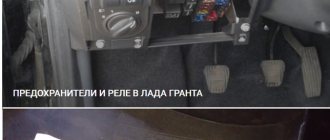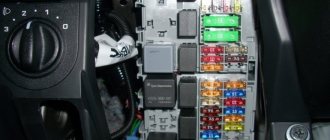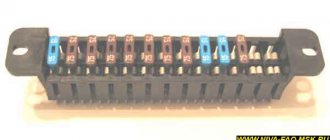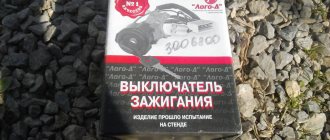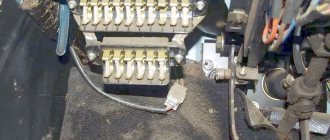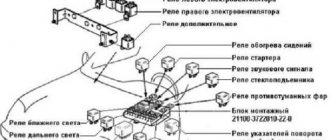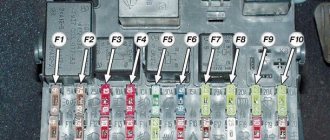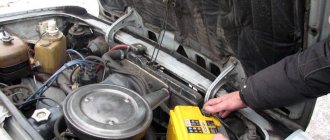Complete information is provided about electrical equipment, wiring, relays and fuses of VAZ-2170 - VAZ-21728 vehicles. The collection is intended for auto electricians and those who, having some knowledge of circuit design, can carry out minor auto repairs with their own hands. The Lada Priora sedan (VAZ-2170) has been produced since 2007, the VAZ-2172 hatchback since 2008, and the VAZ-2171 station wagon has been produced since 2009. In 2013, the car was modernized and they began installing an AMT robotic gearbox (21723, 21728).
There are 4 main harnesses in the Priora electrical circuit:
- from the instrument panel;
- providing motor control;
- front electrical harness;
- rear electrical harness.
All these harnesses are connected to each other using detachable connections. The connectors are located under the dashboard. Each of the harnesses is assigned a serial number.
In addition to the main ones, there are also secondary ones:
- installed in the front passenger door;
- identical in both the left and right rear doors;
- installed in the driver's door;
- connecting the backlight of the license plate;
- connecting the electrical package.
Each element in the diagram corresponds to a number with an explanation. Since all elements are standardized, their designations are identical on car diagrams of all car manufacturers. Next to each electrical appliance, the connectors that go to them are indicated. The pins or sockets of the pads are also numbered.
Lada Priora wiring block diagrams
1,2,3,4 – blocks of the instrument panel wiring harness to the blocks of the rear wiring harness; 5 – block of the instrument panel wiring harness to the block of the ignition system wiring harness; 6,7,8 – blocks of the instrument panel wiring harness to the blocks of the front wiring harness; 9 – lighting control module; 10 – ignition switch; 11 – on-board computer mode switch; 12 – windshield wiper switch; 13 – passenger airbag module; 14 – light signaling switch; 15 – instrument cluster; 16 – hours; 17 – diagnostic block; 18 – recirculation switch; 19 – control unit for windshield wiper and external lighting; 20 – micromotor gearbox for driving the heater control damper; 21 – rear window heating switch; 22 – alarm switch; 23 – brake signal switch; 24 – electric amplifier control unit; 25,26 – blocks of the instrument panel wiring harness to the radio; 27 – mounting block: K1 – relay for turning on low beam headlights and side lights; K2 – relay for turning on the heated rear window; K3 – starter activation relay; K4 – additional relay; K6 – relay for turning on the high speed windshield wiper (automatic mode); K7 – headlight high beam relay; K8 – sound signal relay; K9 – relay for turning on the alarm sound signal; K10 – relay for turning on fog lights; K11 – relay for turning on the electric heating of the front seats; K12 – windshield wiper activation relay (intermittent and automatic modes). 28 – lampshade lighting of the glove box; 29 – glove box lighting switch; 30 – automatic lighting control switch; 31 – electrical package controller; 32 – controller of the automatic climate control system; 33 – rotating device; 34 – driver airbag module; 35 – sound signal switch.
1 – oil pressure warning lamp sensor; 2 – coolant temperature indicator sensor; 3 – main fuse block; 4 – controller power supply fuse (7.5 A); 5 – fuse for the power supply circuit of the electric fuel pump (15 A); 6 – ignition relay fuse (15 A); 7 – Priora ignition relay; 8 – electric fuel pump relay; 9 – throttle position sensor; 10 – idle speed regulator; 11 – coolant temperature sensor; 12 – ignition system harness block to the instrument panel harness block; 13 – solenoid valve for purge of the adsorber; 14 – speed sensor; 15 – mass air flow sensor; 16 – crankshaft position sensor; 17 – diagnostic oxygen sensor; 18 – Priora Lada controller; 19 – rough road sensor; 20 – control oxygen sensor; 21 – pads for the ignition coil harness and ignition system harness; 22 – ignition coils; 23 – spark plugs; 24 – Lada Priora injectors; 25 – phase sensor; 26 – knock sensor; 27 – pads of the ignition system harness and injector harness.
1 – right headlight; 2 – right front speed sensor; 3 – reverse light switch; 4 – electric motor for washers; 5 – windshield wiper motor; 6 – engine compartment lamp switch; 7 – electric fan of the engine cooling system (left); 8 – starter 2170; 10 – rechargeable battery; 11 – main fuse block; 12 – VAZ2170 generator; 13 – ABS hydraulic unit; 14 – air temperature sensor; 15 – brake fluid level sensor; 16 – alarm signal; 17 – sound signal; 18 – left front speed sensor; 19,20,21 – front wiring harness blocks to the instrument panel wiring harness blocks; 22 – left headlight VAZ-2170; 23 – right fog lamp; 24 – left fog lamp; 25 – air conditioning system pressure sensor; 26 – air conditioning compressor; 27 – air conditioner electric fan (right); 28 – air temperature sensor (air conditioning system); 29 – rear window washer electric motor; 30 – block of the front wiring harness to the block of the heater wiring harness; 31 – right electric fan relay; 32 – left electric fan relay; 33 – additional relay (sequential activation of left and right electric fans); 34 – heater electric fan relay; 35 – compressor relay; 36 – compressor power supply fuse (15 A); 37 – fuse for the power supply circuit of the electric heater fan (40 A); 38 – front wiring harness block to rear wiring harness block; 39 – fuse for the power supply circuit of the right electric fan (30 A); 40 – fuse for the power supply circuit of the left electric fan (30 A).
1 – rear wiring harness block to the instrument panel wiring harness block; 2 – rear wiring harness block to additional wiring harness block 2 (left rear door); 3 – rear wiring harness block to side door wiring harness block (right front door); 4 – left side direction indicator; 5 – electrical package controller; 6 – right side direction indicator; 7 – interior lighting unit; 8 – handbrake warning lamp switch; 9 – left lamp of Lada Priora; 10 – right lamp; 11 – interior air temperature sensor; 12 – interior lamp switch in the driver’s door pillar; 13 – switch for the interior lighting in the pillar of the right front door; 14 – switch for the interior lighting in the pillar of the right rear door; 15 – interior light switch in the left rear door pillar; 16 – block of the rear wiring harness to the block of the wiring harness of the side doors 2 (left front door); 17 – rear wiring harness block to the additional wiring harness block (right rear door); 18 – blocks of the rear wiring harness to the rear right loudspeaker; 19 – blocks of the rear wiring harness to the rear left loudspeaker; 20 – cigarette lighter VAZ-2170; 21 – electric fuel pump module; 22, 23 – rear wiring harness blocks to instrument panel wiring harness blocks 2,3; 24 – trunk lighting; 25 – additional brake signal; 26 – trunk lock drive switch; 27 – interior lamp; 28 – rear wiring harness block to the front wiring harness block; 29 – left rear speed sensor; 30 – right rear speed sensor; 31 – sensor for automatic glass cleaning system (rain sensor); 32 – rain sensor sensitivity regulator; 33 – rear wiring harness block to instrument panel wiring harness block 4; 34 – block of the rear wiring harness to the block of the wiring harness of the parking system sensors; 35 – alarm unit for safe parking system; 36 – driver’s seat belt pretensioner; 37 – passenger seat belt pretensioner; 38 – rear wiring harness block to side door wiring harness block 3 (right front door); 39 – airbag control unit; 40 – parking system control unit; 41 – block of the rear wiring harness to the block of the rear additional wiring harness (tailgate); 42 – rear wiring harness block to rear additional wiring harness block 2 (tailgate); 43 – left seat heater; 44 – switch for electric seat heaters; 45 – right seat heater. 46 – rear wiring harness block to the parking system switch.
Useful: Sensor with car washer fluid level indicator
Features of the bodies of “Ladovo” models
ATTENTION! A completely simple way to reduce fuel consumption has been found! Don't believe me? An auto mechanic with 15 years of experience also didn’t believe it until he tried it. And now he saves 35,000 rubles a year on gasoline! Read more"
Since we started with QOL, let’s continue this topic. For the frame of Ladovsky models without glued glass, the quality of life is 14 thousand N*m/degree, which is a very good mark. And with glass this figure is even higher.
The testing of the Lada body in the rear turned out to be especially good. Thus, in the rear door opening, after a tough diagonal pressure test, the changes were recorded as only 1.5 mm, whereas on most foreign cars the same figure was 5-6 mm.
The body design of the Lada Largus and other similar models fundamentally complies with current European standards in terms of protecting passengers and the driver. The front subframe on Ladovsky models is one of the most important body elements responsible for this indicator. It is even considered an auxiliary spar, significantly increasing the strength of the body, as well as absorbing impact force.
The high quality of life of the Ladovsky body also has a beneficial effect on obtaining high-quality sound comfort in a car showroom. The frame does not twist over bumps and bumps, no deformations or anomalies occur between the interior and body elements, which ultimately has a positive effect on the absence of squeaks.
Note. Of course, in addition to the quality of life indicator, the quality of interior elements also affects the high level of sound comfort. They were obtained through proper calculation so as not to come into contact with the body in places where squeaking might occur. This was achieved by fixing the plastic components with special fasteners and minimizing the various gaps that arise one way or another between them and the body.
A lot of original parts, interchangeability of interior elements between Ladovsky models, enlargement of some parts of the body - all this was only a plus. In particular, the increase in some body elements led to a decrease in their number, which reduced production time and had a positive effect on performance.
Lada Largus
Called a budget station wagon with increased cross-country ability. The body was assembled based on Dasia/Renault Logan. The car was initially adapted for the market of Eastern European countries.
Even in the basic version of Logan, engineers took effective measures to enhance anti-corrosion protection, using protective inserts for the wheel arches. In addition, anti-corrosion and anti-gravity protection is installed over larger areas than before (at Samarov’s vehicles), with a thicker layer of mastic.
Here are some more innovations:
- The engine compartment is well protected. Additional protection was used correctly;
- The front suspension reinforcement has been increased. This was achieved through the use of leverage;
- The washer reservoir has become larger and holds more fluid;
- The wheels received protective aprons;
- The change got a torpedo;
- The bumper and radiator grille have been modernized.
It is noteworthy that the station wagon is made in 2 body versions: 5-seater and 7-seater. In addition, a van is also produced. The price of cars is low - only 350 thousand rubles and good comfort. When compared with foreign cars, the cost is heaven and earth.
In general, the Largus exterior is designed in such a way that it makes it possible to rightfully call the car roomy. A large family, along with bags and suitcases, as well as pets, fits comfortably inside. As for the design, the abundance of straight lines gives the car some speed and dynamism to the slightly clumsy family station wagon.
Height with rails is 167 cm, which is 10 cm more than Dasia Logan. The remaining sizes are also quite individual and do not copy “anyone”.
Lada Kalina
A car with 4 body types: sedan, regular 5-door hatchback, station wagon and sports hatchback.
"Sedan" version
Let's start with the sedan:
- From the new family of Kalina cars, AvtoVAZ is produced;
- The modern elegant appearance and comfortable interior are called the root reasons for the sedan's good sales;
- It has good handling at high speeds;
- It maneuvers well in the city traffic rhythm;
- Practical and incredibly convenient for daily use;
- The sedan body received wedge-shaped silhouette lines, visually creating the image of a strong, brutal car;
- The opening angle in the luggage compartment has been increased by 120 degrees, which makes loading easier. Inside the trunk, the manufacturer has wisely provided special loops that allow you to secure the cargo being transported.
Instrument cluster block diagram
| № | Decoding |
| 1 | Electric power steering |
| 2 | Emergency gang control VAZ-2170 |
| 3 | Connection to oil pressure sensor |
| 4 | Parking brake indicator light |
| 5 | Electronic anti-theft device |
| 6 | Airbag control module |
| 7 | External lighting switch |
| 8 | Right turn signal indicator and doubler |
| 9 | Left turn signal indicator and backup |
| 10 | Engine control unit |
| 11 | Disabling the passenger's front airbag |
| 12 | Seat belt warning light |
| 13 | ABS brake system unit |
| 14 | Steering column switch button |
| 15 | Brake expansion tank indicator |
| 16 | ABS safety control module |
| 17 | Main beam headlight control unit |
| 18 | Shield backlight module |
| 19 | General disadvantage of the device |
| 20 | Constant positive battery terminals |
| 21 | Ignition switch contact |
| 22 | Fuel flow meter |
| 23, 24 | Steering wheel turn switches |
| 25,26 | Overboard temperature sensors |
| 27 | Fuel sensor VAZ-2170 |
| 28 | Speed sensor |
| 29 | Coolant temperature sensor |
| 30 | Tachometer signal |
| 31 | Shield diagnostics |
| 32 | Generator Regulator Relay Terminal |
Electrical connection diagram for heater wiring harness PRIORA 21723
- heater wiring harness block to the front wiring harness block;
- air mixing gearmotor;
- evaporator temperature sensor;
- electric fan 2172;
- speed controller;
- recirculation gearmotor.
Parking system sensor diagram 2172-3724248
1,2,3 – parking system sensors; 4 – block of the wiring harness of the parking system sensors to the block of the rear wiring harness.
Rear license plate light pinout
1. Supply voltage to the lights illuminating the rear number 2,3. Priora 4 license plate lamps. Electric trunk lid locking motor
Vehicle check
To ensure traffic safety and increase the service life of the vehicle, it is necessary to periodically carry out external and internal inspections of the vehicle.
The length of the inspection depends on how well you know your car and how often you use it. While operating your car, you will learn about the rate of oil consumption in the engine and gearbox, brake and coolant, and the reliability of various systems and devices. This will allow you to plan your actions and time to inspect the car in the future. For example, if it turns out that the engine consumes oil quite intensively (albeit within normal limits), then the oil level in the engine sump should be monitored more often. If the oil consumption of your car’s engine is low and there is no visible change in the oil level over a month, you can limit yourself to a monthly check. The more familiar the car inspection activities become for you, the less time you will spend on them. However, if you encounter difficulties in servicing the car yourself or suspect that it is faulty, you must contact one of the service centers for servicing this car model. Source Location of components and assemblies (bottom view) : 1 - mudguard of the power unit; 2 — gearbox; 3 — front suspension stretch; 4 — left wheel drive; 5 — front suspension arm; 6 — anti-roll bar; 7 — transmission control rod; 8 — jet thrust of the gearbox control mechanism; 9 — tubes of the power supply and brake systems; 10 — additional muffler for the exhaust gas system; 11 — pressure regulator in the hydraulic drive of the brake mechanisms of the rear wheels; 12 — fuel tank; 13 — rear suspension beam; 14 — main muffler of the exhaust gas system; 15 - niche in the bottom of the trunk for a spare wheel
Bottom view of the front part of the car (the power unit mudguard has been removed for clarity) : 1 - front wheel brake mechanism; 2 — engine sump; 3 - generator; 4 — cross member of the front suspension; 5 - starter; 6 — gearbox; 7 — left wheel drive; 8 — anti-roll bar; 9 — transmission control rod; 10 — jet thrust of the gearbox control mechanism; 11 — additional muffler pipe; 12 — right wheel drive; 13 — front suspension stretch; 14 — front suspension arm
From the outside of the car we check : – air pressure in the tires: inspect them for damage; – tightening the wheel bolts; – serviceability of lighting and alarm devices. You can check the operation of the brake signals without an assistant by pressing the brake pedal and watching in the rearview mirror for the reflection of the signal light from a wall, such as a garage; – no traces of leakage of oil, coolant, fuel and brake fluid.
In the engine compartment we check : – engine oil level; – oil level in the gearbox; – coolant level in the expansion tank of the cooling system; – brake fluid level in the brake hydraulic reservoir; – presence of liquid in the windshield washer reservoir; – generator drive belt tension; – condition and fastening of battery cable terminals.
Inside the car we check : – serviceability of the vacuum brake booster; – operation of the clutch and gearbox drives; – the amount of travel of the parking brake lever; – serviceability of the sound signal; – serviceability of the windshield cleaner and washer; – serviceability of instrumentation; – fuel level in the tank; – adjustment of rear view mirrors; – serviceability of door lock mechanisms.
Lighting control unit diagram
| G, 56b | To the gear motor for adjusting headlights |
| 58b | Output to backlight sources |
| 31 | Mass (ground) |
| Xz | +12 volts (from terminal 15 of the ignition switch) |
| 56 | To the relay for switching high and low headlights |
| 1,3 | From rear and front fog lights |
| 2,4 | To the rear and front fog lamp relays |
| 58 | For lamps of Lada Priora dimensions |
| 30 | +12 V from terminal No. 30 of the ignition switch |
Sound insulation of the Priora engine compartment is done independently
Priora soundproofing of the engine compartment, starting from the partition
Soundproofing a Priora is a process that does not require you to have car repair skills, so anyone can do it themselves in a matter of hours. You just need to know the necessary materials, tools and the procedure to perform the actions. You also need to be attentive; the resulting quality of sound insulation depends on your attentiveness when performing the work, and our instructions will help you deal with the rest. Lada Priora is today the newest model in the VAZ family, however, Priora, like other domestic car models, has such an inherent drawback - too high a noise level inside the cabin. The main source of this noise is, of course, the engine. To cope with this nuisance and make your car trips more comfortable, the solution would be comprehensive sound insulation for the Lada Priora engine compartment. When soundproofing the engine compartment, the following feature is taken into account - in order to achieve maximum effect, it is necessary to insulate the engine shield on both sides - both in the engine compartment and inside the cabin. To do this, you will have to remove the dashboard and disassemble everything that prevents you from gaining access to the shield.
Priora relay and fuse blocks
Location of relays and fuses in the DELRHI 15493150 mounting block
Location of relays and fuses in the mounting block 1118-3722010-00
Lada Priora relay - purpose
K1 Relay for turning on low beam and side lights of headlights (automatic lighting control system) K2 Relay for turning on heated rear window K3 Relay for turning on starter K4 Additional relay K5 K6 Relay for turning on high speed (automatic mode) windshield wiper K7 Relay for turning on high beam headlights K8 Relay for turning on sound signal K9 Relay for turning on the sound alarm signal K10 relay for turning on the fog lights K11 relay for turning on the electric heating of the front seats of the headlights
Lada Priora fuses - purpose
F1
Reserve
F2 (25 A)
Mounting block, relay for turning on the heated rear window (contacts) Electrical package controller, contact “10” of the XP2 block Rear window heating element
F3 (10 A)
Right headlight, high beam lamp Instrument cluster, high beam headlight indicator
F4 (10 A)
Left headlight, high beam lamp
F5 (10 A)
Mounting block, horn relay Horn
F6 (7.5 A)
Left headlight, low beam lamp
F7 (7.5 A)
Right headlight, low beam lamp
F8 (10 A)
Mounting block, alarm horn relay Sound alarm signal
F9
Reserve
F10 (10 A)
Instrument cluster, pin “20” Brake light switch Brake light lamps Interior lighting unit Interior lighting lamp Threshold lamp, right front doors Additional brake light
F11 (20 A)
Mounting block, windshield wiper high speed relay Wiper and washer switch, terminal “53a” Wiper and washer switch, terminal “53ah” Rear window heated switch Mounting block, rear window heated relay ( winding) Windshield wiper motor Rear window wiper motor (2171, 2172) Windshield washer motor Rear window washer motor (2171, 2172) Airbag control unit, pin “25”
F12 (10 A)
Instrument cluster, pin “21” Electrical accessories controller, contact “9” of the block X2 Electromechanical power steering control unit, contact “1” of the block X2 Reversing light switch Reversing light bulbs Parking system control unit, contacts “11” and “14”
F13 (15 A)
Cigarette lighter
F14 (5 A)
Side light lamps (left side) Instrument cluster, main light switch indicator License plate lights Trunk light Electrical package controller, pin “12” of block X2
F15 (5 A)
Side light lamps (right side) Storage lamp box
F16 (10 A)
Hydraulic unit, contact “18”
F17 (10 A)
Left fog light
F18 (10 A)
Right fog light
F19 (15 A)
Seat heating switch, contact “1” Front seat heaters
F20 (10 A)
Switch recirculation (switch on) Mounting block, relay for low beam headlights and parking lights (automatic lighting control system) Heater electric fan relay Automatic lighting control switch Windshield wiper and external lighting control unit, contacts “3”, “11” Automatic climate control system controller , pin “1” Automatic windshield wiper sensor (rain sensor), pin “1”
F21 (5 A)
Light switch, pin “30” Diagnostic deck, pin “16” Clock Automatic climate control system controller, pin “14” "
F22 (20 A)
Windshield wiper motor (automatic mode) Mounting block, windshield wiper relay and high speed windshield wiper relay, (contacts)
F23 (7.5 A)
Wiper and exterior lighting control unit, contact " 20”
F24-F30
Reserve
F31 (30 A)
Electrical package controller, terminal “2” of the block X1 Electrical package controller, terminal “3” of the block X1 Driver’s door module, pin “6” Threshold light of the left front door
Reserve F32
VAZ 2170 (Priora) 2004+ General information about the car
The small class car VAZ-2170 Lada Priora with a four-door sedan body (class C according to the international classification) is designed for operation at ambient temperatures from –40 to +50 °C on public roads with hard surfaces. The Lada Priora is equipped with an injection 16-valve engine mod. located across the engine compartment. VAZ-21126-00 with a working volume of 1.6 liters. The engine is equipped with a distributed fuel injection system and an exhaust gas catalytic converter, structurally made in a single block with the exhaust manifold (catcollector). The body is load-bearing, all-metal, of welded construction, with hinged doors, front fenders, hood and trunk lid. The driver's seat of the Lada Priora is equipped as standard with an airbag, and in an optional version - with a front passenger airbag, as well as front seat belts with pretensioners and load limiters, which significantly reduces the likelihood and severity of head and chest injuries in a traffic accident.
| Overall dimensions general information about the car Lada Priora VAZ 2170 | Section 1. Design of the Lada Priora VAZ 2170 car The small class car VAZ 2170 Lada Priora with a four-door sedan body (class C according to the international classification) is intended for operation at ambient temperatures from -40 to +50 °C on public roads with hard surfaces . The VAZ 2170 Lada Priora is equipped with an injection 16-valve engine of the VAZ 21126-00 model located across the engine compartment with a displacement of 1.6 liters. The engine is equipped with a distributed fuel injection system and an exhaust gas catalytic converter, structurally made in a single block with the exhaust manifold (catcollector). The body is load-bearing, all-metal, of welded construction, with hinged doors, front fenders, hood and trunk lid. The driver's seat of the VAZ 2170 Lada Priora is equipped as standard with an airbag, in an optional version - with a front passenger airbag, as well as front seat belts with pretensioners | and load limiters, which significantly reduces the likelihood and severity of head and chest injuries in a traffic accident. NOTE The airbag only deploys if there is a severe impact to the front of the vehicle. In minor frontal impacts, vehicle rollovers, rear or side impacts, seat belts are the primary means of protection. The transmission on the VAZ 2170 Lada Priora is made using a front-wheel drive design with drive wheel drives of different lengths. The front suspension is independent, spring, with anti-roll bar, with hydraulic shock absorber struts. The rear suspension is semi-independent, lever-spring, with hydraulic shock absorbers. The front wheel brakes are disc brakes with a floating caliper, the rear wheels are drum brakes. In a variant version, VAZ 2170 Lada Priora cars are equipped with an anti-lock brake system, which prevents wheel locking during braking and maintains controllability and directional stability. | The steering is injury-proof, with a rack-and-pinion steering mechanism, with an electromechanical booster that changes the transmitted torque depending on the speed of the vehicle. VAZ 2170 Lada Priora cars are equipped with a remote control system for locking or unlocking door locks (in a variant version and locking the trunk lid lock) with simultaneous activation or deactivation of the vehicle security mode. In addition, remote activation of the alarm system in case of violation of vehicle security zones and blocking of all doors by pressing a button from inside the vehicle are provided. This system also includes an electronic engine locking system (immobilizer), which provides additional protection against unauthorized engine starting. The overall dimensions of the VAZ 2170 Lada Priora car are shown in Fig. 1.1, technical characteristics are given in table. 1.1. Elements of the engine compartment of the VAZ 2170 Lada Priora are shown in Fig. 1.2, the location of the main components and assemblies is shown in Fig. 1.3 and 1.4. |
| The airbag only deploys when there is a strong impact to the front of the vehicle. In minor frontal impacts, vehicle rollovers, rear or side impacts, seat belts are the primary means of protection. |
The transmission is made according to a front-wheel drive design with drive wheels of different lengths. The front suspension is independent, spring, with anti-roll bar, with hydraulic shock absorber struts. The rear suspension is semi-independent, lever-spring, with hydraulic shock absorbers. The front wheel brakes are disc brakes with a floating caliper, the rear wheels are drum brakes. In a variant version, Lada Priora cars are equipped with an anti-lock brake system, which prevents wheel locking during braking and maintains controllability and directional stability. The steering is safety-resistant, with a rack-and-pinion steering mechanism, with an electromechanical booster that changes the transmitted torque depending on the speed of the vehicle. Lada Priora cars are equipped with a remote control system for locking or unlocking door locks (in an optional version and locking the trunk lid lock) with simultaneous activation or deactivation of the vehicle security mode. In addition, remote activation of the alarm system in case of violation of vehicle security zones and blocking of all doors by pressing a button from inside the vehicle are provided. This system also includes an electronic engine locking system (immobilizer), which provides additional protection against unauthorized engine starting.
The overall dimensions of the car are shown in Fig. 1.1, technical characteristics are given in table. 1.1.
| Rice. 1.2. Engine compartment of the car: 1 – engine; 2, 14 – supports of the power unit; 3 – steering mechanism; 4 – throttle unit; 5 – reservoir of the main brake cylinder; 6 – expansion tank of the engine cooling system; 7 – main fuse block; 8 – washer reservoir; 9 – battery; 10 – air filter; 11 – mass air flow sensor; 12 – alarm signal; 13 – generator; 15 – hood stop |
Elements of the engine compartment of the VAZ-2170 Lada Priora are shown in Fig. 1.2, the location of the main components and assemblies is shown in Fig. 1.3 and 1.4.
| Rice. 1.3. Location of the main components of the vehicle components (bottom front view, engine splash guard removed): 1, 3, 13 – power unit supports; 2 – generator; 4 – radiator of the engine cooling system; 5 – electric fan of the engine cooling system; 6 – starter; 7 – front suspension cross member; 8 – front suspension extension bracket; 9 – front suspension extension; 10 – shock absorber strut of the front suspension; 11 – stabilizer strut; 12 – left front wheel drive; 14 – gearbox; 15 – front exhaust pipe of the additional muffler; 16 – engine oil sump; 17 – catalytic collector; 18 – right front wheel drive; 19 – anti-roll bar; 20 – front suspension arm; 21 – front wheel brake mechanism |
| Rice. 1.4. Location of the main components of the vehicle components (bottom rear view): 1 – separator; 2 – main muffler; 3 – shock absorber struts of the rear suspension; 4 – spare wheel niche; 5 – fuel tank filling pipe; 6 – rear suspension beam; 7 – fuel tank; 8 – fine fuel filter; 9 – suspension cushions for the exhaust gas system; 10 – brake pressure regulator |
Table 1.1 Technical characteristics of cars
What are they needed for
The name “drainage holes” speaks for itself. They are designed to drain rainwater, condensation or moisture after washing. Automakers know where water can most often collect and have prudently made technological holes at the lowest points of these places.
In some cases, they are large and connected to the street by pipes. In other cases, these are simply holes in the metal elements of the body. If they were not there, moisture would accumulate in the blind cavities of the car. They would begin to rot from the inside. This is witnessed by cars with through corrosion in the lower part of the doors, sills and fenders. It seems that there is no chip, but the “red” has already appeared.
We will analyze in detail for each popular VAZ model where they are located. In most cases, the location of the drainage holes on VAZ models is the same, but there are nuances. Let's start with the "classics".
Where to begin
First of all, many people ask questions about the advisability of the soundproofing procedure specifically on the engine side in the engine compartment.
There is an opinion that this is a completely useless event. And supposedly there is no meaning in it. But this is said mainly by those who have not felt the difference between cars with and without sound insulation, or who initially drive a car that has high-quality and efficient noise insulation from the factory. In the second case, I really don’t see the point in further insulating the engine compartment. But this occurs mainly on expensive and new cars. Owners of older and cheaper cars are less fortunate.
Cars that have been in use for more than one year, produced more than 10 years ago, usually have high noise and vibration from the engine. And even when running at idle.
And you shouldn’t blame only diesel engines. Gasoline engines also vibrate a lot and require additional noise.
How to choose a coolant
Answering the question of what antifreeze to use in Priora, the manufacturer did not provide a large assortment to its users. It is best to use the Felix-40 cooler. You can use other brands, but this is not recommended. The engine system may wear out in a shorter period of time. As a result, you will have to contact the service for global repairs and replacement of parts.
If you are using antifreeze from another manufacturer, it is recommended to study its characteristics. It must meet international quality standards.
How to check the fluid level and how much will be enough?
To determine how many liters of coolant are needed to fill the tank, carefully read the vehicle's owner's manual. You will need approximately 7.8 liters. Some car owners prefer to fill a little less - 6 liters.
You can check the antifreeze level in the tank even on a cold engine. To do this, lift the hood lid. You will see a tank. There are two marks on it with a maximum and a minimum value. The fluid level must be within these marks.
Refinement of the cooling system
Domestic cars are far from perfect, that's a fact. Lada Priora was no exception in this regard, having inherited many shortcomings from the legendary “ten”. One of them is an unfinished cooling system.
There are several ways to quickly and without financial costs modify the SOD on Priora.
- Installing a 6-hole thermostat (stable maintenance of coolant temperature).
- The use of Kalina SOD on Priora will reduce the pressure in the system and provide quick warm-up at subzero temperatures.
- Installing a larger or additional water pump to improve coolant circulation efficiency.
- Use of multi-speed and silent forced cooling fan.
- Changing the firmware of the control unit so that the fan operates at a lower temperature.
Refining the cooling system of the Lada Priora is a feasible task even for novice car enthusiasts. The SOD has a simple design with a minimal set of components. Thanks to this, the system is relatively reliable.
The main rules for washing a car under the hood, which will make the engine clean and shiny
Receive one of the most read articles by email once a day. Join us on Facebook and VKontakte.
Some believe that washing the engine is at least unsafe, and there is no practical sense in it. Many drivers have been driving with oily engines for decades and have no problems. Others seriously believe that you need to wash the engine regularly, at least once a year, and preferably twice.
A lot of facts can be cited in favor of both statements, because a clean engine a priori carries so many advantages that every vote against it will look at least ridiculous. On the other hand, the wrong approach to carrying out water procedures under the hood can lead to serious consequences from problems with the engine to electrical and electronics.
In rare cases, negligence when washing an engine can even lead to a fire.
So is it necessary to wash the engine, and how to do it correctly? We’ll talk about this and much more in the continuation of the article.
Disadvantages of low engine operating temperature
- The most basic problem is increased fuel consumption (read how to reduce fuel consumption on a Lada Granta here).
- There is also a risk of breakage.
- Well, the car interior will not warm up so well.
Remedies
Only replacing the thermostat with a model with an opening temperature of at least 92 degrees will help. Grantmakers purchase a WAHLER 3091.92D thermostat, take the insides out of it, and insert it into the old thermostat.
In order not to disassemble the original thermostat ahead of time, you can purchase a thermostat for the Lada Granta, and put the insides from a non-original replacement into it.
This is a native Luzar thermostat
Installation instructions for an additional electric pump
Communities Lada Priora Lada Priora Club Blog Micro FAQ 2. Checking the functionality of the expansion tank cap Installing an additional water pump on any car (including the Lada Priora has 16 valves) is basically no different. It is necessary to place the electric pump in the section of the pipe, which is the input or output to the car’s stove and provide its power supply.
Step-by-step instructions for installing this additional component are as follows:
- Provide access to the heater pipes under the hood of the car by removing components that interfere with operation.
- Compress one of the rubber pipes that comes out of the heater (stove), which is done to prevent coolant from leaking out, or drain antifreeze (antifreeze) from the entire system.
- Cut part of this pipe to the length of the corresponding pump being installed.
- The length of the fittings is not taken into account due to the fact that they fit into the pipes.
- It is necessary to select the diameter of the fittings on the electric pump in advance to obtain a high-quality connection.
- Secure the rubber pipes to the pump fittings using metal clamps.
- Attach the additional electric pump to a pre-selected location under the hood of the car (indicated above) using special fasteners.
- Connect the power supply to the pump by selecting the options listed above, or install a separate switch.
- Start the engine and check the tightness of the connections, as well as the functionality of the electric pump.
- Install all parts that were removed before installing the pump.
Delivery by transport company
Delivery by one of the transport companies with a representative office in your city. Delivery time: 2-10 days depending on the distance of your locality from Togliatti. The most convenient and fastest way to deliver orders of different sizes. Delivery cost from 250 rub. depending on weight and delivery distance.
Orders are sent by transport companies based on 100% payment for the order. Dispatch by transport companies PEK, KIT, Baikal-Service is carried out on Wednesday, Thursday and Friday.
